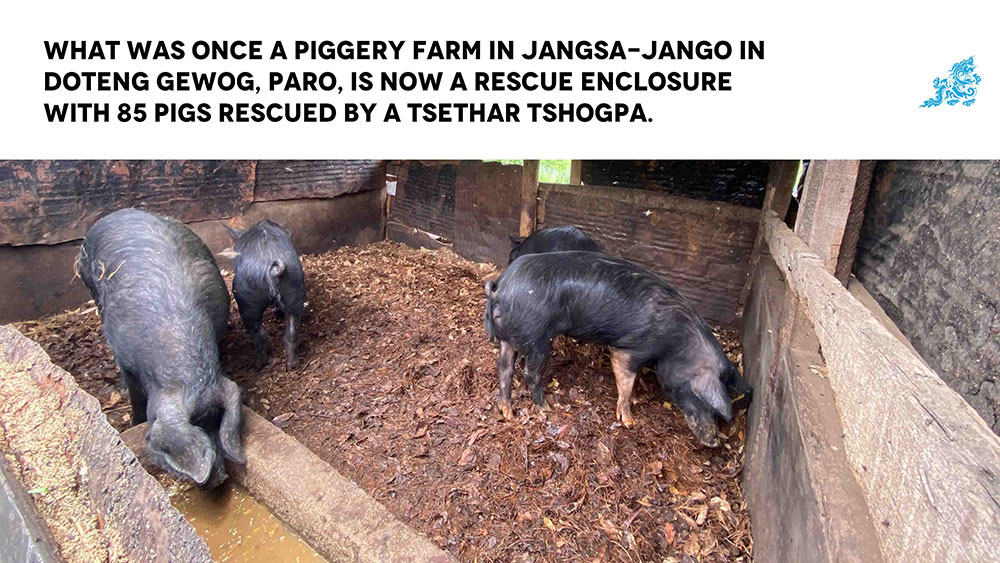Phub Dem | Paro
Flies hover around the pig sty in Jangsa-Jango, Doteng gewog, in Paro. The feedlot is cramped and the stench is sickening. Waste from the sty goes into a stream and Dohchhu.
What was a piggery farm before is today a pig rescue enclosure. There are 85 pigs rescued by a tsethar tshogpa. It has been more than three years since the rescued pigs are kept at Jangsa-Jango.
The locals, however, want the place to be relocated.
Doteng Gup Letho said that the place was leased to a private individual for two years. After the lease term ended, the tshogpa rescued the pigs and kept them there without the gewog’s approval.
The people approve of tsethar tshogpa’s initiative to recuse the pigs but complain about lack of cleanliness and monitoring.
“There is an waste storage tank, but it is not being used. In fact, the waste flows directly in the stream which poses health risks to the people,” Letho said.
The stream sources water to three gewogs of Doteng, Dopshari, and Hungrel.
Letho said that the relocation delay had also affected the construction of gewog’s archery ground.
The gups of Doteng, Dopshari, and Hungrel wrote to the dzongkhag administration sometime in June last year about the poor hygiene in the area.
The letter states that although the gewog had requested the tshogpa to relocate the enclosure, there was no response from the association.
The dzongkhag administration sent a directive in February this year stating that a committee headed by dzongkhag livestock should inspect the area. The committee confirmed the place was unclean and was polluting the stream.
The committee’s findings state that the piggery is located at the heart of the village and near a stream and Dohchu, violating health protocol and environmental guidelines.
“In consultation with the gewog, the association has to relocate the stall at the earliest,” it suggested.
Sangay, the landowner, said that he leased out the land only for two years to the private individual and as a temporary shelter to the association with the condition that no more pigs should be brought in. “There were only 12 pigs earlier. The tshogpa keeps on bringing pigs from around the country.”
He said that people who depend on the stream threatened him. “They’ve asked me to take the risk if anything happens to them because of the contaminated water.”
Sangay said that the rescued animals do not get proper shelter and feeding. “Stray dogs scavenge on the dead pigs that are buried. It might spread diseases.”
The request to relocate the rescued animals had fallen on the association’s deaf ears, Sangay said.
However, the tsethar tshogpa denied the allegations.
According to a senior member of the tshogpa, Nima Dem, the association rescued 61 pigs worth Nu 1.5 million. She said that Sangay had given the tshogpa permission to use the land for as long as there are animals in the enclosure.
She said pig excrement polluting the stream was not valid because the stream above the sty was already polluted irrigation water. “The irrigation water from the paddy which consists of pig manure, fertilisers and pesticides drain into the same stream.”
In fact, she claimed that the local people were happy with the sty, as they collect manure and supply vegetables and rice husks to the pigs.
She said that the association had explored suitable place in Wangdi, Punakha, Thimphu, and Paro to relocate but failed.
With these issues, Nima Dem said, the association could neither repair the sty nor provide proper shelter to the rescued animals. “Without other option, our request is to keep the animal where they are until they die.”
“We will relocate the area near the field to accommodate the archery ground. We will cover the stall and make sure that the stench doesn’t affect the players if the pigs are allowed to stay there, “ Nima Dem said.
Edited by Jigme Wangchuk


